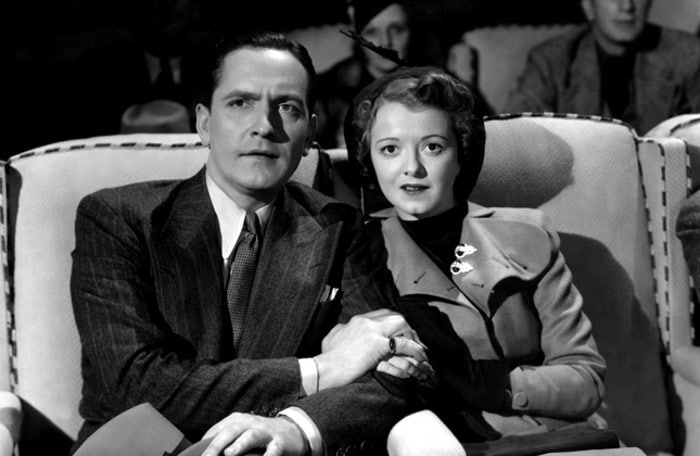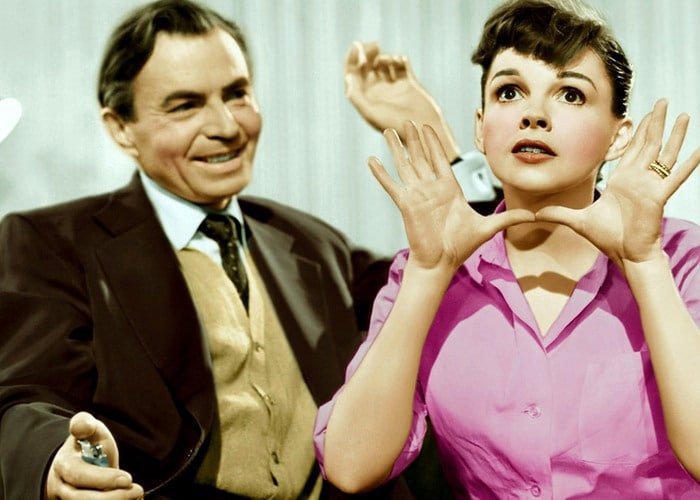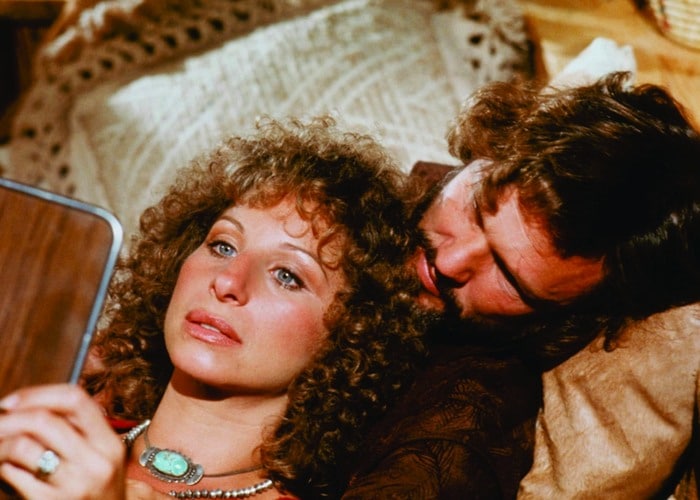Bradley Cooper’s directorial debut is not the first birth of A Star Is Born. In fact, you could say the film is a reincarnation of an old soul, a third time over. Now, audiences will see the fourth adaptation of the classic Hollywood story. The feature will also see Lady Gaga harnessing her acting talents and Bradley Cooper, in an unseen role, operating behind the camera. With Cooper’s country-pop-music clad, updated A Star Is Born coming out of Venice and Toronto International Film Festivals with glowing reviews; critics fawning over the film, we take a look back at previous iterations and the 1937 original, their approach to substance abuse, examination of male fragility and toxicity, and the molding of women in the star system. Let’s dive in.
1937

Starring: Janet Gaynor & Fredric March
The original A Star Is Born from 1937 shows off a glossy, dewy-eyed examination of the Hollywood star system. Janet Gaynor’s charisma and optimism seem almost too good to be true, surviving on her hopes and dreams as the food for her journey from the Midwest to tinsel town. When a secretary at an extras casting office tells Esther, she has a one in a million chance at making it, Esther replies, in a cautiously convincing manner, “But maybe I’m that one.”
It’s at a cocktail party where Gaynor’s Esther Blodgett meets Norman Maine. Norman (Fredric March) has a reputation that precedes him. His dependence on alcohol is viewed throughout the film with a lack of empathy. Norman lumbers along, sometimes slurring his words, more often tripping over himself. It feels more comical than a cause for concern as the enablers around Norman passively say the actor is, “having a good time.” Most of Norman’s associates are more concerned with the star’s image than the man himself. “Work is beginning to interfere with his drinking,” one producer lackadaisically says. At the beginning, and throughout the film, more people are concerned about what the press could say about Norman rather than his own wellbeing.
As Norman Maine’s star begins to dull, his ego becomes more temperamental. Norman becomes relegated to Esther’s secretary, as her star alter-ego Vicki Lester becomes more popular. In one scene, he answers the phone, makes her dinner, and when signing for a package is referred to as Mr. Lester, the ultimate blow. Where Norman may have taken some comfort in his life with Esther, acting in the film’s narrative as the cure for his troubles, the once beloved actor finds himself officially a has-been, regressing behind the image of his wife. Norman becomes more violent, assaulting his own wife due to his alcoholism and helpless state. But an altercation towards the end of the film highlights Norman’s selfhood as more fragile than previously and the film’s problem in its commentary on substance abuse.
Libby, a Hollywood fixer, and Norman run into each other at a bar during a horse race, as the latter orders a ginger-ale. Norman is walking a thin line, monitoring himself, trying to better his circumstances. “They let you wander around without a handler,” remarks Libby with a sour, soulless sneer. “I don’t feel sorry for you,” he boasts again, and here is all we need to know about the film’s view on Norman’s state. Norman is time and again referred to for his alcoholism in a light far from empathetic. Upon Norman’s death, Libby jokes, “Greatest drink of water he had in years.” It’s a cruel reminder of the commodification of stars, where Norman became a cog in a machine who had to be turned correctly but otherwise left alone.
Unlike the lack of attention afforded to Norman, Esther receives too much. She is no longer Esther Blodgett. Her name and biography become warped for the studio’s purposes, positing a ‘Cinderella of the Rockies’ by the name of Vicki Lester instead of Esther Blodgett who dreamed of stardom. Vicki is trained for the role of her life, learning how to speak, walk, and look like a star. “We have to do something about that right away,” said the men attempting to make the young woman over. After signing her contract, she is instructed by an executive, “learn to close your mouth.” Esther’s mouth remains closed metaphorically from that point on, as she takes on the role she’ll play for the rest of her career: Vicki Lester.
Looking back at the original, we know more about the commodification of old Hollywood stars. There were actors and actresses, staples of the classic period, who changed their name, hair and performed the star role for the press and otherwise. If anything, Norman and Esther are tragic composites of the early classic period. While the film does show what is at stake in the crusade for stardom and celebrity, it barely scratches the surface when examining Norman’s addiction as an effect of the intoxicating and stressful world he lives in. Norman’s fragility is echoed by his cries for help through his actions, while Vicki/Esther feels an obligation to stand by her husband and possibly lose her career.
1954

Starring: Judy Garland and James Mason
Less than 20 years after the original, 1954’s A Star Is Born sings a familiar tune, but with slightly more empathetic attitude. Judy Garland headlines this showstopper. Her iconic vibrato and screen presence make her a force. But in the shoes of Esther Blodgett, Garland has to play more sheepish. This Esther is a star who just needs a chance to shine. Norman Maine enters to make that a reality.
Building the ideal Vicki Lester, Garland undergoes a physical transformation. Quite literally under the microscope, Esther visibly cringes over the changes that must be made. When she asserts her opinion, she is told, “Please little lady, this man is thinking.” Donning a fake nose, red wig, and too much rouge, once Norman sees her he laughs at her made-up appearance. On a slight credit to the film, her make up is removed, Esther’s appearance remains. But even after this, she is asked to not show her face during one of her first scenes in a picture. Once an opportunity is finally given to Esther to shine, front and center, it is perfection. From there, she is later referred to as, “the hottest piece of property the studio has, right now.” Commodifying her presence, talent, and bankability, Esther is, as she hoped to be earlier in the film, ‘made.’
In the making of Esther, there is the unmaking of Norman Maine, whose star persona dims as his struggles with alcoholism become more apparent. Norman’s characterization in the 1954 iteration has a slightly more empathetic appeal if only due to the emotional rawness and exposure to how Esther is affected by those circumstances. His dependency on alcohol is presented as a problem right away, but he is still handled by producers and executives around him, babysat and steered in various directions to prohibit full chaos. Norman’s work is still seen as a way for him to handle his substance dependency. He enters a rehabilitation facility, with slightly less taboo than the 1937 film, but his wounded ego cannot be healed.
The brighter Esther’s star burns, the more fragile Norman becomes. People begin to forget his appeal or recognize him. In a reconstructed scene from the original, Norman answers the door to sign a package for Esther and is referred to as Mr. Lester. Mason, as Norman, takes a long pause at the door, almost slowly realizing his lack of stardom depletes his purpose. He turns back to drinking, assaulting his wife in the process, asking to ‘borrow her speech’ at the Oscars so he can make an embarrassing verbal tirade. This Norman is pitiable. He cannot bear being eclipsed by his wife and so must act out and abuse himself to handle the situation. With little help or support from those he was once close to, Norman finds himself alone at a bar ordering a ginger-ale when Libby stands next to him. At the thought of living off of his wife, Norman becomes physical with Libby. Here, though, Norman is the one who falls to the ground, literally and metaphorically knocked down. From there he goes on a downward spiral, leading Esther to believe in order to save him she must give up her career, saying, “I’m giving him back the gift he gave me,” as she sees Norman as the reason for her success, rather than her own talent.
1954’s A Star Is Born hits all the familiar beats of the original with a more pitiable examination of how Norman’s addiction effects Esther. Norman is a more fully realized man with his stardom as his purpose and screen presence his masculine quality that eventually evades him. All of this leading to a fragile masculinity that can only be cured with more drinking and physical altercations. Mason’s performance makes it seem that Norman really did want to better himself, but when he pulled Esther from her career found that the only way to let her move on was to tragically end his life. Esther, in the end, takes on the name of her departed husband in the final scene.
Watching the film back with more historic context, it’s tragic to think of Judy Garland’s unmatched talent and screen presence in contrast to her life behind the scenes. Her treatment on countless productions leads to many of her own struggles, following a path that the film romanticizes for the sake of Norman and Esther.
1976

Starring: Barbra Streisand and Kris Kristofferson
Almost 40 years after the original, A Star Is Born with Barbra Streisand and Kris Kristofferson turns the examination of stardom in classical Hollywood to the corrosive celebrity of musicians in the 1970s. Kristofferson plays has-been Rockstar, John Norman Howard, with Streisand as Esther Hoffman, the blossoming star with a powerful voice and songwriting skill to match. This iteration stands further from the previous two. It’s a whole different spin, looking at musicians versus actors in a different time period. But the themes and structure remain the same.
To the film’s credit, Esther isn’t made over by men. Streisand embodies Esther as a firm, independent woman dedicated to her work. She’s resilient and less lenient to put up with John Norman’s antics until she finds herself too invested in their relationship. After being dragged on stage by John, giving a crowd-pleasing performance, she’s asked if she’ll change her name. She insists, of course, she wouldn’t. With that, Vicki Lester is a distant memory of the Hollywood star system. But even Esther’s physical appearance goes unchanged. If anything, she is given a glitzy, glamorous wardrobe fit for a ‘70s pop performer (assembled by Streisand, herself). With this iteration, the pair works together, rather than forming separate careers at first. But as Esther’s star rises, yet again, John finds himself without purpose, forlorn and stuck in the shadow of his wife.
Kristofferson’s John Norman Howard doesn’t hide under the guise of a gentleman. Upon meeting Esther, he regards her with phrases like, “Jesus, you talk a lot,” or “You’ve got a great ass.” His personality, antics, and drug addiction and alcoholism are framed as just a part of the Rockstar lifestyle. Like the original, Esther is posited as the possible antidote to his problems. Further echoing both of the previous films, Esther finds herself in an unbalanced situation. Once she goes on the road to tour, the wheels fall off and yet again a sense of responsibility returns to her.
John’s masculinity is toxic and violent. Combined with his unaddressed substance abuse, he shoots a gun at a helicopter, breaks glass, and finds himself in physical altercations time and again. Without his Rockstar status, his ego becomes fragile and he finds himself regressing as Esther becomes a more prominent fixation. He battles with it, like the Norman Maines before him, and cannot seem to win or have people invest in him to rise above his abhorrent behavior. Even when Esther calls him to the mat, nothing positive comes of it. “Is it me?” she asks following an embarrassing Grammys telecast. “I love you Johnny, but it’s not enough is it?”
Instead, John cheats on Esther, sleeping with a reporter so she may get an interview with the newfound star. A low point for the couple’s relationship, the toxicity of their partnership is mimicked through a physical altercation and a back and forth of, “I hate you,” and “I love you,” that sees the pair riding horseback into the sunset in the following scene.
By the end of the film, it’s unclear if John finds ending his life a release for him or for Esther, leaving it to ambiguity. Esther addresses herself as Esther Hoffman Howard, taking her husband’s last name as a badge of pride. In the end, her career continues with resounding applause and a show-stopping number. But like the previous iterations, a woman is left feeling that she could have done more to save the man who made her a star.
Fast-forward to 2018, where Bradley Cooper’s turn as a director has him examining stardom, celebrity, and substance abuse in A Star Is Born. With further investigation into the latter, Cooper’s iteration focuses more on the growth of characters rather than the key notes that are hit in each incarnation. By focusing on the characters, Ally and Jackson, Cooper may very well show audiences the struggles and flaws of untouchable stars. Perhaps Cooper and Gaga will take note from the opening lyrics of the trailer, “…it’s time to let the old ways die,” but still retain Sam Elliott’s own philosophical phrasing. “Music is essentially twelve notes between any octave. Twelve notes and the octave repeats. Just the same story told over and over. All any artist can offer the world is how they see those twelve notes.” Audiences will search for something new to the fabled stories of stars when they see how far from the shallow Cooper and Gaga will swim to adapt an iconic story for a 2018 audience.
The post The Previous Versions of ‘A Star is Born,’ Explained appeared first on Film School Rejects.
No comments:
Post a Comment